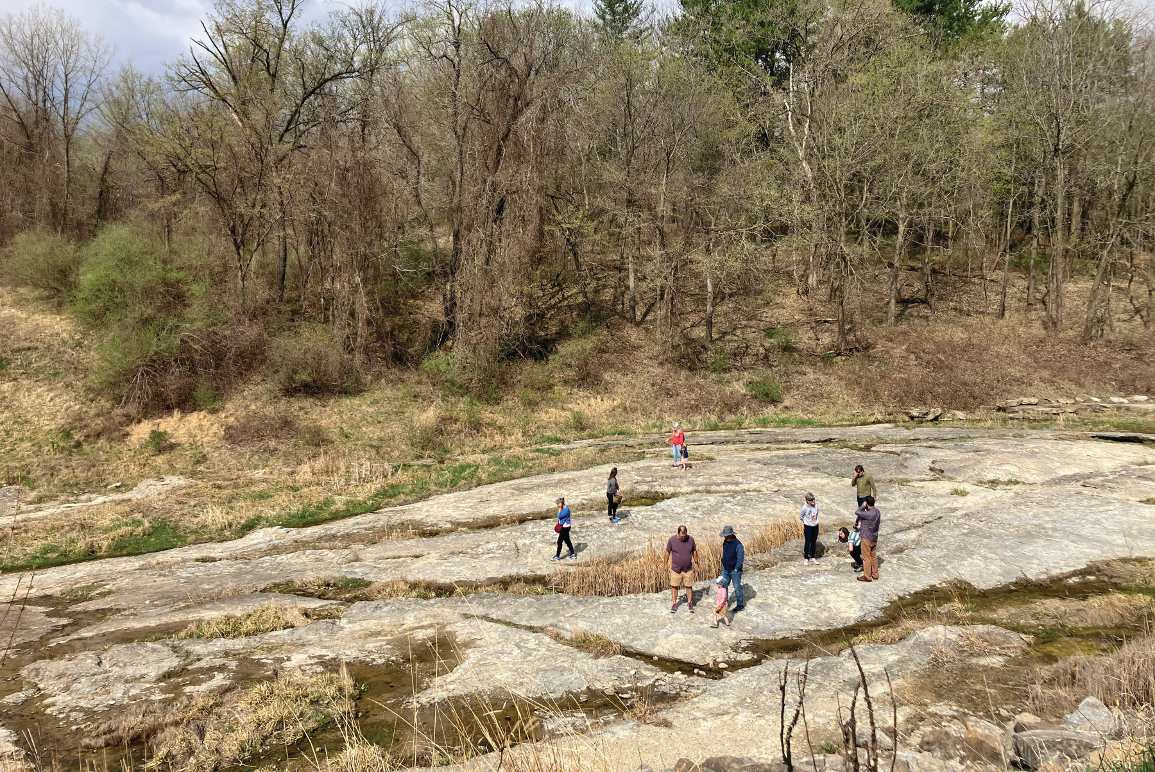
Sixty-five million years? Please. You want to see something old, head to the Coralville Dam.
It’s not the dam that’s old, though it has survived almost seven decades and two near-apocalyptic floods. In fact, it was the first of these floods in 1993 that breached the 712-foot spillway and inundated the campground below, washing away many centuries of concrete, soil and sediment to reveal a geological treasure trove — stones and fossils dating back more than 350 million years to the Devonian age, when this land was covered by a shallow sea.
The Devonian age isn’t as action-packed as the more recent Triassic, Jurassic and Cretaceous periods, which saw many-ton dinosaurs and scrappy mammaliaforms battle for survival amid massive volcanic eruptions and meteorite strikes. The period lasted 60 million years, beginning roughly 420 million years ago. Sea levels were high during the Devonian. The weather was warm and arid, the land glacierless. Earth’s first forests began sucking up carbon, depositing it into the ground.

Dubbed the Age of Fishes, the Devonian saw armored fish known as placoderms earn apex-predator status in almost every aquatic environment on the globe. Some lake-dwelling fish developed lungs and muscly pectoral and pelvic fins, eventually taking the first gloppy steps on land. These fish are the ancestors of all four-limbed vertebrates, from dinosaurs to humans.
Meanwhile, a bunch of organisms with scientific names thrived on the reef floor: brachiopods, bryozoa, hederellids, microconchids, crinoids, trilobites, bivalves, bactritoids. Now-extinct classes of cephalopods floated along in horn-like or circular, spiral shells. These ammonite fossils would appear alien — all spiky, spiny, brittle, tubular and shell-covered — if they weren’t some of the most iconic fossils on record.

During the Devonian, most of North America and Europe formed a south-of-the-equator continent called Laurussia, which gradually shifted north and rotated counterclockwise (ruffling Earth’s tectonic feathers in the process). The period finally ended 360 million years ago with the start of the Late Paleozoic Ice Age, which gave way to Pangea, mountain ranges, deserts and dino-palooza. But for much of the period, Laurussia was home to inland seas, typically clear, warm and shallow. Evidence of these extinct seas can be found in parts of England, Belgium, New England and the Midwest.
Which brings us back to Coralville.
Fossil Gorge fascinated the public as soon as it opened on Labor Day weekend in 1993, attracting tens of thousands of visitors a day. Because locals and out-of-staters were so enticed by a 375-million-year-old limestone sea floor in one of the most comically landlocked states, a committee was formed to develop it into a tourist attraction. Half a million in donations were collected and, with the help of the Army Corps of Engineers, the park was dedicated in 2001 — complete with an entry plaza, biostrome plaza, handicap accessible walkway, 20 educational “discovery points” marked by hexagonal signs within the gorge, and other park features — making it the perfect (free) field trip for families and local elementary classrooms.

But the Flood of 2008, which crested even higher than the ’93 flood, did a number on visitor amenities: ruining sidewalks, markers and the biostrome plaza. But while certain points of interest were washed away, others were revealed. Even more of the 200-foot-thick Devonian bedrock was exposed, especially on the southern end of the gorge, and new discovery points were flagged.
Fossil looters have been the biggest enemy of the gorge, but run your eyes over the stone floors and walls and you’ll still see evidence of Devonian corals (Hexagonaria and Favosites, in particular); crinoids, starfish-like animals that looked like plants (the stemmed variety are also called sea lilies); and brachiopod shells with their distinctive wide hinges.
You may even spot bits of calcite glimmering from fractures in the limestone floor — caused by all that continent shifting — or trilobite fossil fragments.
But even if a river of sludge breached the spillway tomorrow, covering up Fossil Gorge once again, researchers have studied and preserved enough of the fossil fauna to keep the Devonian alive in the 21st century. There are dozens of exhibits, sites and educational opportunities around Iowa attesting to the impact of Devonian-era geology, ecology and climate science on life today. Below are some of the top spots.
University of Iowa Museum of Natural History
Macbride Hall, Iowa City
Admission: Free

Apart from Rusty the giant Ice Age ground sloth, one of the most well-known displays at this public science museum — tucked inside UI’s historic Macbride Hall — is a life-size depiction of a Devonian reef floor. The diorama provides a vivid glimpse of Fossil Gorge, 380 million years ago, showing colorful crinoids, corals, trilobites, brachiopods, cephalopods, small fish and the T Rex of the Devonian sea: the 20-foot-long armored predator, Dunkleosteus.
Fossil & Prairie Park Preserve
1227 215th St, Rockford
Admission: Free
Located one mile west of Rockford, Iowa along the Winnebago River, this is one of the only fossil-rich sites in Iowa where the public can legally play finders-keepers with Devonian marine fossils. Trails wind through native prairie, past beehive kilns built in the early 20th century, and into a fossil quarry, ripe for discovery. Seek more information about the local landscape inside the visitors center.
The Putnam Museum & Science Center
1717 W 12th St, Davenport
Admission: $8-9, free for children 2 and under
An early donation to this 150-year-old Quad Cities museum was a collection of crinoid stem pieces found in Burlington in 1868. A slab of crinoids hailing from Le Grand, Iowa was added later, and the Devonian sea lilies — regarded as Iowa’s unofficial state fossil — still sit among geodes and agates in Putnam’s popular Fossils and Minerals exhibit.
Rock, Mineral & Fossil Show
Hawkeye Downs, Cedar Rapids
March 23-24, 2024
Admission: $1-3, free for children 12 and under

Presented by the nonprofit Cedar Valley Rocks & Minerals Society for 58 years, this two-day expo is a dream come true for any fan of rocks, fossils, crystals, gems, jewelry, artisanal gifts, craft fairs and Iowa geological history. Kids can sluice sediment, make footprint casts and fill bags with tiny tumbled stones, while adults shop at dozens of dealer tables. All ages can benefit from the educational displays (including a table of information and coloring pages from the Iowa Geological Survey) and feel time fold like an accordion while viewing rare agates and fossils older than even Chuck Grassley.
Maquoketa Caves State Park
Admission: Free

One of the most awe-inspiring natural sites in Iowa, many of the rocks that make up the 13 caves, formations and natural bridge in this state park were once buried under Devonian strata. The park is dominated by Silurian dolomite, formed from lime deposits left by 430-million-year-old tropical seas. Fossil Gorge-esque limestone is visible in some of the bluffs, but the best geological gems can be found in the dolomite rock: fossils and molds of fossils from crinoids, coral, sponges, snails, clams and other Silurian sea critters. Bring a flashlight and you just might spot ’em!
Fryxell Geology Museum
Augustana College, Rock Island
Admission: Free
Come for the 22-foot Cryolophosaurus skeleton, T rex skull cast and wall of glowing, fluorescent rocks — stay for the Sirulian and Devonian plant fossils that sit among Augustana College’s 20,000-piece geology collection.
Emma McClatchey and her third-grade class took a field trip to Fossil Gorge in 2002. It was thrilling, until she accidentally smacked her head against a wood post and had to go to the E.R. with a concussion. This article was originally published in Little Village’s June 2023 issue, Rec’d

